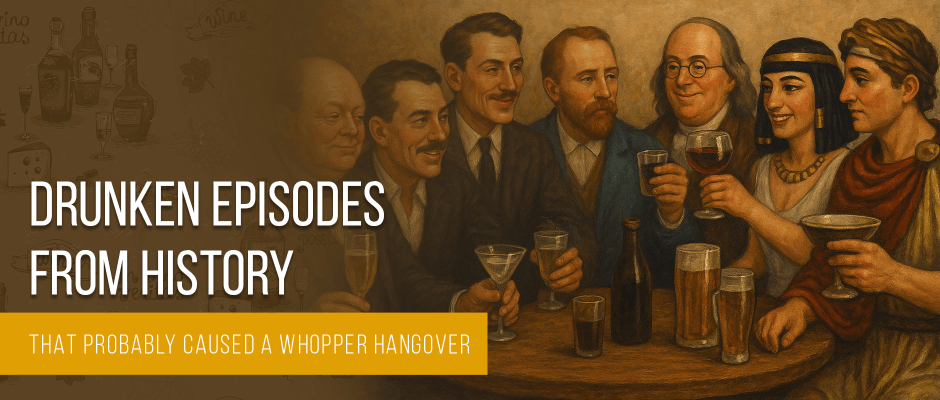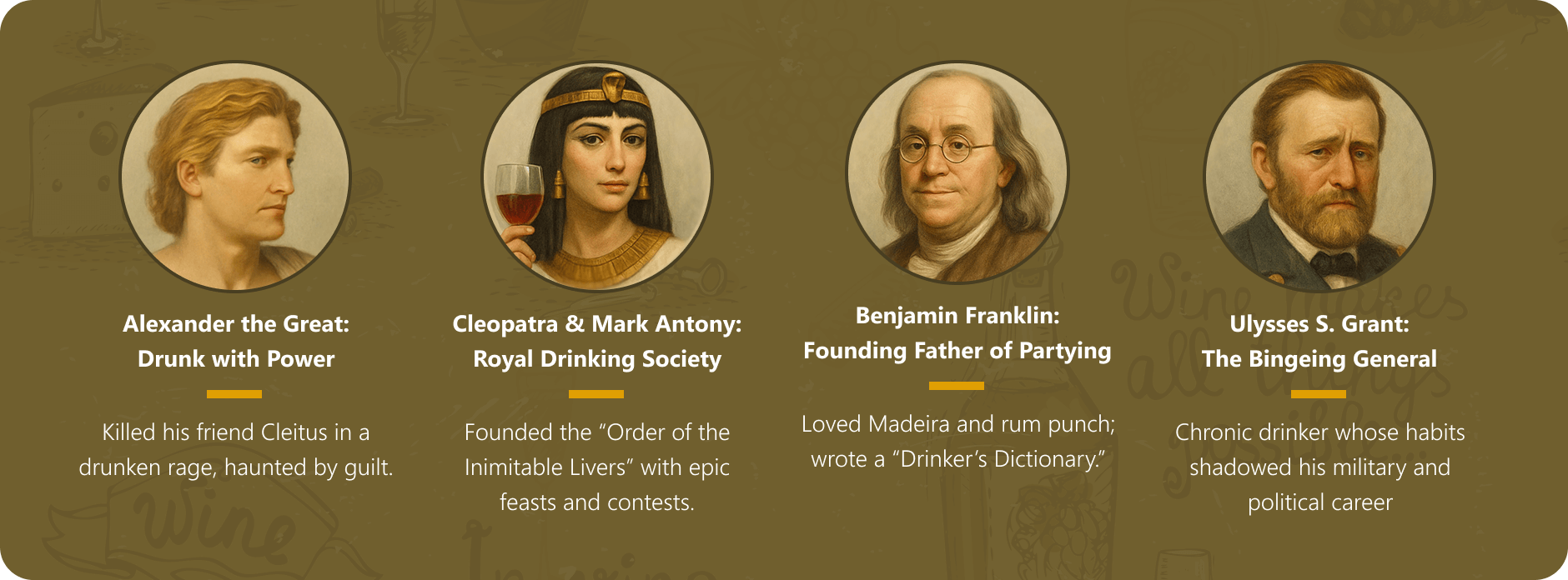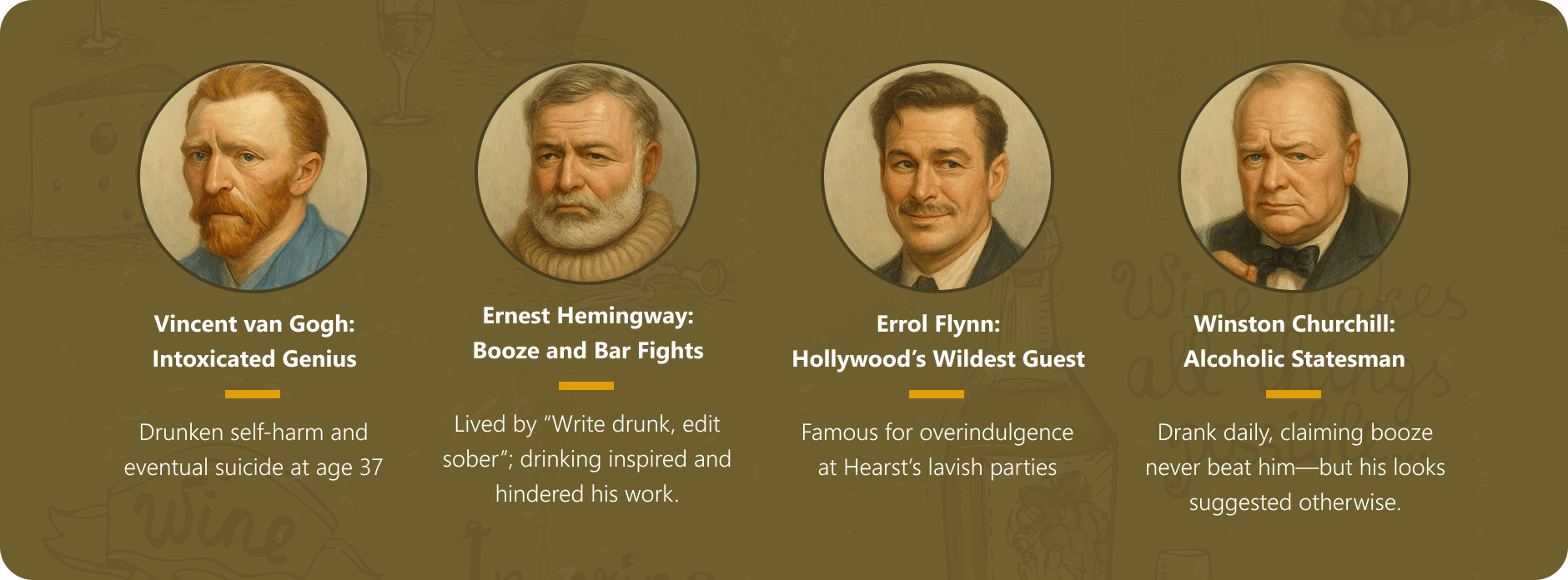
Drunken Episodes from History that Probably Caused a Whopper Hangover
Most people who imbibe in alcohol have a tale or two to tell about nights of over-indulgence that left them with regrets the next morning. In fact, human history is rife with accounts of alcohol-fueled episodes that have stood the test of time. Learn about some of history’s most notable drunken capers that were immortalized in the annals of history, and which no doubt resulted in whopper hangovers.
Also learn about a new IV drip for hangovers that has finally cracked the code for hangover relief.
Timeline of Human Alcohol Consumption
Evidence of human alcohol consumption predates written history, based on archaeological discoveries of vessels containing residue of fermented sugars from fruit, honey, rice, and grains like wheat and barley. Fermentation is a process where sugar is acted upon by yeast or bacterial cultures, converting it to CO2 and ethanol – the form of alcohol we consume.
The history of alcohol fermentation closely parallels the evolution of agriculture, as humans learned to cultivate plants for food. In ancient Mesopotamia, the process of brewing beer was documented on clay tablets, and there is evidence that beer and wine were part of daily culture in ancient Egypt. There is even evidence that workers were sometimes paid in beer.
In ancient Greece and Rome, wine played a key role in the lives of the elites, and was closely tied to social status. Wine was an integral part of religious ceremonies and rituals, and the Romans are credited with spreading viticulture across Europe. However, in Greece, public drunkenness was frowned upon, and wine was often diluted with water.
Throughout the Middle Ages, processes for cultivating and brewing both wine and beer were refined, and methods for preservation were advanced. At the same time, native societies in the Americas were making pulque from agave – a precursor to tequila – and chica was a popular type of corn beer made by Andean cultures.
As the world’s populations grew and migrated, methods for distilling alcohol spread abroad, and hard liquors like brandy and whiskey became prevalent. European colonialism in the New World introduced rum made from sugar cane, and new international trade routes transported wine and spirits across the planet.
With the advent of the Industrial Revolution, mass production of alcohol made it cheaper and more accessible to the masses, and processes like pasteurization were introduced to ensure consistent quality. Pubs that featured alcohol became popular gathering spaces, and drunkenness began to spread as a social plague that led to prohibition in the US from 1920-1933 – an unsuccessful effort that led to illegal alcohol production and organized crime.
Today, vintners, brewers and distillers continue to reinvent and expand their products to remain competitive, and to satisfy consumer demands. Despite competition from other forms of intoxicants like cannabis and mushrooms, alcohol remains an integral part of modern culture, and hangovers remain its natural consequence.
Epic Tales of Alcohol-Induced Capers
Recorded history is full of ribald tales of inebriated celebrities, some anecdotal and others well-documented. Despite some potential health benefits, alcohol can be highly addictive for some people, leading to chronic alcoholism that harms the liver and destroys lives. Nevertheless, the drunken capers of our favorite historical figures provide entertainment and make them more relatable.
Here is a rundown of some of history’s more notable drunken capers:
- Alexander the Great, circa 324 BCE, conquered much of the civilized world, but his frequent drinking benders became legendary. In a drunken rage, he is said to have argued with Cleitus, one of the generals who had saved his life in battle, killing him with a spear. As recorded by Plutarch, he was haunted by remorse afterward, and he no doubt suffered a punishing hangover to boot.
- Cleopatra was known for her wealth and beauty, but also for throwing elaborate feasts. Together with Mark Antony, she founded a dining society called the “Order of the Inimitable Livers” that featured hard-core drinking contests. According to Plutarch, the Queen’s capacity for throwing back shots rivaled that of Antony, and the two no doubt nursed wretched hangovers together.
- Benjamin Franklin is well known for his intellect and diplomacy, but he was also quite the lady’s man and party animal. His letters record in detail his weakness for Madeira and rum punch, and he even published a “Drinker’s Dictionary” featuring 200+ euphemisms for drunkenness.
- Another famous American, President Ulysses S. Grant was well known to be a chronic drinker, indulging in frequent binges, according to his aide John Rawlins. Grant is said to have resigned from his Army commission due to excessive drinking. As President, his penchant for alcohol became fodder for the political gossip mill, especially among his rivals.

- Vincent Van Gogh – a brilliant impressionist known for his mastery of color and light – had a reputation for melancholy, and even spent a year in a mental hospital. He is said to have cut off his ear while intoxicated, and eventually took his own life in 1890, at the young age of 37.
- Errol Flynn was just one of dozens of famous Hollywood actors known for wild carousing and flagrant overindulgence. He was a frequent guest at parties thrown by publishing magnate William Randolph Hearst, where he was known to be publicly intoxicated.
- American novelist Ernest Hemmingway was a hard-core drinker whose motto was, “Write drunk, edit sober.” Hemmingway haunted the bars of Key West on a nightly basis, and frequented El Flor in Havana, throwing back daiquiris and mojitos. According to biographers, Hemmingway’s drunken binges spawned many a bar fight, and hangovers stifled his creativity. Yet in famous works such as “The Sun Also Rises,” Hemmingway glorified drinking.
- British Prime Minister Winston Churchill was a notoriously heavy drinker, known to kick off his day with a glass of Scotch. While he held his liquor well, his love of whisky, champagne, and brandy was no secret. Rumor has it that he consumed at least one bottle of champagne a day, boasting that, “I have taken more out of alcohol than alcohol has taken out of me.” However his portly physique and dissipated appearance suggest otherwise.

Hangover IV Therapy – Finally a Remedy that Really Works!
Like many common illnesses, hangover symptoms taper off and disappear after they run their course. But in today’s fast-paced world, who has time to wait? A hangover IV cocktail offers a fast and effective morning-after remedy that can salvage your day.
- Vitamin C to boost your immune function
- B-Complex vitamins, including B6 and B12, to promote recovery
- An electrolyte mix to support brain and nervous function
- Medications for nausea and headache
- A saline fluid solution, to eliminate dehydration
Your hangover IV session takes about an hour. During that time, you recline comfortably in a spa-like environment as potent ingredients are infused, drip-by-drip. Use that time to doze, scroll social media, or prepare for the work day ahead. By the time your session is up, your symptoms should already be fading, and you will feel better as the day progresses.
Get Fast and Effective Hangover Relief in NYC
In the age of tech, daily work requires sharp mental focus and the ability to respond quickly to life’s demands – actions that are impossible with a hangover. At Invita Wellness, our hangover IV cocktail is the fastest way to beat hangover symptoms so you can seize the day with confidence. Keep us on speed-dial for quick hangover relief, or pre-schedule your hangover IV session for the morning after your next big event!
Get Fast and Effective Hangover Relief in NYC
contact InVita Wellness today
Book Now
456 Broadway 2 Floor, New York, NY 10013, USA
Resources
Mortlock, Stephen. “A history of alcohol consumption.” (2024).
A history of alcohol consumption